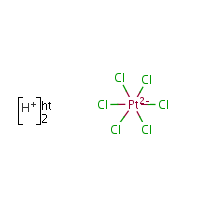Platinic chloride
Agent Name
Platinic chloride
Alternative Name
Chloroplatinic acid
CAS Number
16941-12-1
Formula
Cl6-Pt.2H
Major Category
Metals

Synonyms
Chloroplatinic acid; Chloroplatinic(IV) acid; Dihydrogen hexachloroplatinate; Dihydrogen hexachloroplatinate(2-); Hexachloroplatinic acid; Hexachloroplatinic(4+) acid, hydrogen-; Hexachloroplatinic(IV) acid; Hydrogen hexachloroplatinate(4+); Hydrogen hexachloroplatinate(IV); Platinum chloride (H2PtCl6); Speier's catalyst; Platinate(2-), hexachloro-, dihydrogen (8CI); Platinate(2-), hexachloro-, dihydrogen, (OC-6-11)-; Platinate(2-), hexachloro-, hydrogen (1:2), (OC-6-11)-; [ChemIDplus] Acid platinic chloride; [Merck Index] Acide chloroplatinique, solide (French DOT); Acido cloroplatínico, solido (Spanish DOT); Hydrogen hexachloroplatinate(IV); Hydrogen platinum chloride (H2PtCl6); [CAMEO] UN2507
Category
Metals, Inorganic Compounds
Description
Reddish-brown solid; Soluble in water; [CAMEO] Brownish or yellow crystals; Deliquescent; Odorless or mild odor of hydrogen chloride; [GFS Chemicals MSDS] Exists as hexahydrate; [Merck Index]
Sources/Uses
Used in plating, photography, mirrors, indelible inks, luster on glass, and acetic acid manufacturing; Also used for platinizing pumice stone, catalyzing sulfur trioxide production, relief etching of zinc (artistic and commercial applications), and fixing microscope preparations; [Merck Index] Used in electroplating; [CAMEO]
Comments
May cause asthma or dermatitis; [Merck Index] A skin and eye irritant; [CAMEO] Hydrate is CAS# 26023-84-7; A skin and eye irritant; Harmful by ingestion and inhalation; Chronic exposure may cause sensitivity; [GFS Chemicals MSDS] Solution: Causes burns; Inhalation may cause corrosive injuries to upper respiratory tract and lungs; May cause respiratory sensitization; Toxic by ingestion; [Sigma-Aldrich MSDS] See "Platinic chloride hexahydrate."
Biomedical References
Exposure Assessment
TLV (ACGIH)
0.002 mg/m3, as Pt
PEL (OSHA)
0.002 mg/m3, as Pt
Adverse Effects
Skin Sensitizer
Yes
Asthma
Yes
Toxic Pneumonitis
Yes
Dermatotoxin
Skin burns
Diseases, Processes, and Activities Linked to This Agent
Diseases
Occupational diseases associated with exposure to this agent:
Processes
Industrial Processes with risk of exposure: